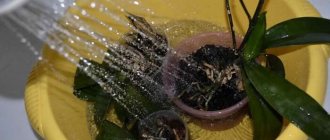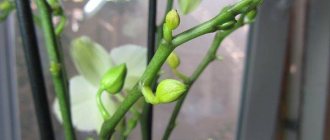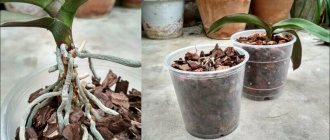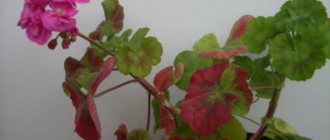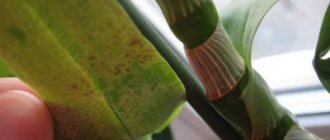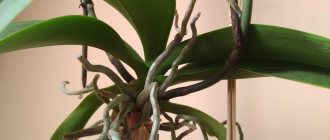What is it and what does it look like?
Blackening of orchid leaves occurs in different ways. Everything will depend on what reason led to this condition. The leaf turns black completely or partially. Additional signs include:
- Necrotic changes throughout the entire leaf blade or part thereof.
- The spots vary in size and color (from brown to gray).
- The spots quickly darken and have a watery content.
- The leaves may turn black at their base, which leads to their subsequent falling off.
- The surface of the leaf becomes covered with a black coating, while losing its elasticity and becoming loose.
- The surface of the leaf may be brown, and then black dots appear on it.
- The veins and tips of the leaves turn black.
- First, black dots of various sizes appear, which eventually merge into one spot.
Most often, all these signs are accompanied by a stop in the growth of orchids and their lack of flowering. Therefore, you should always inspect your favorite plant and, in case of suspicious manifestations, immediately begin resuscitating the flower.
Important! If the orchid leaves become damp and show signs of rotting, this means that the painful process has already affected the roots of the plant. Therefore, in this case, you need to start treatment with the flower’s horse system.
You can learn more about the types, causes and prevention of depigmentation of leaves, flowers and roots of orchids in this article.
Causes of blackheads and ways to prevent the disease
Identifying the reasons for the appearance of black dots on an orchid will help you quickly cope with the plant’s disease and save it. Black spots may appear after purchasing an orchid from a store. But most often this happens due to improper care. These tropical plants have not received the attention and conditions they need.
- If yellow spots appear, the plant may have been exposed to too much sun. On the window where the flower stands, you need to create a shadow.
- The second cause of stains is improper watering. Due to prolonged exposure to water, the root may turn black and rot. The roots of some types of these flowers need to be dried after watering. Others like to be watered only from the top.
- Another reason is incorrectly selected soil. It is important to choose a container of the right size and with holes for the flower.
- Excessive use of fertilizers and fertilizing also has a bad effect on the orchid.
- When transplanting, damage to the roots and poor quality tools will lead to disease.
- The appearance of pests will lead to weakening of the flower.
If the plant is sick, you need to take immediate action.
- You need to isolate it from other colors.
- Cut out all affected areas.
- Organize the correct watering regime, process the cuts, trim only with clean tools.
- And there is no need to rush to remove the plant from quarantine.
To prevent the appearance of black dots and spots on the plant you need:
- organize proper watering;
- work only with treated substrate;
- provide humidity and temperature control;
- carry out preventive treatment against pests and diseases.
What is it a sign of?
As a rule, the leaves of a home orchid turn black due to errors in care. But if the grower does everything according to the rules, then the cause may be various diseases.
Read more about what leaf diseases occur in orchids, what their symptoms look like in the photo, and why you shouldn’t delay treatment here.
Septoria
The disease is caused by Septoriaselenophomoides microorganisms. First, wet dark spots appear on the leaves, which then dry out and leave behind blackening. Over time, they turn yellow and merge into a single large spot. After all these processes, the leaves begin to fall off. The following types of orchids are most often susceptible to this disease: Cymbidiums, Oncidiums, Cattleyas.
Spot (black or bacterial)
The disease develops due to viruses, resulting in dark or black dots (sometimes lines) appearing on the leaves. The disease is considered contagious and spreads quickly. Therefore, damaged leaves are immediately removed so that the virus does not penetrate the root system.
Mosaic
This is also a viral disease that most Cymbidiums suffer from. Dark spots first appear on the leaves, in place of which a hole then forms. Mosaic develops against the background of mechanical damage to the flower. The carriers are insects.
Fusarium
The causative agents of the disease are fungi from the genus Fusarium. First, black bubble spots form on the leaf, then the leaves begin to crumble and fall off. The disease can occur due to excessive moisture, hypothermia or soil salinity.
Leaves turn yellow and dry out
Orchids seem so delicate that many owners are afraid to breathe on them too much. The main thing is not to panic if the leaves begin to dry out or turn yellow.
— Most often, orchids suffer from burns because the lighting is not suitable for them, because different species have different requirements;
— The leaves turn yellow and dry, and the shoots become thinner in the last stages of fusarium. This is a disease of the root system, so periodically inspect the root zone;
— Yellow stains in the form of rings, ovals and diamonds cover the leaves of an orchid that has picked up the cymbidium mosaic;
— Bizarre ring patterns appear on orchids infected with the odontoglossum virus. On broadleaf varieties, the appearance is slightly different, and they are covered with bizarre lines and strokes.
Photo: cypressgarden.ru
Leaf diseases in phlox: descriptions with photos, treatment
Why is this happening?
In addition to diseases, there are many reasons for blackening of orchids, ranging from improper watering to infections. The leaves turn black completely or partially due to errors in care or the following errors in creating the conditions for keeping orchids:
- If the air in the room is too dry or, on the contrary, humid.
- Frequent or infrequent watering that does not correspond to a certain season (how to save an orchid damaged by the flood?).
- If there is high air temperature, most often it is +30 and above.
- Low temperatures also negatively affect the flower. Temperatures from +18 and below can damage it.
- If the flower has been damaged by a mite. Usually, such damage on leaves can be detected immediately.
If you place a pot with an orchid in close proximity to a heater, the result can be a thermal burn. Such spots on the leaves are brown or black with multi-colored edging. A heat burn looks the same as a sunburn. These are usually dark spots with a yellow outline.
How to save a plant
When the color of the foliage changes, when it becomes limp and dry, begin to take urgent measures to restore it. First aid is to remove healthy orchids that grow next to the diseased plant. Neighboring flowers may become infected, after which many more of these plants will need to be revived. Examine the sick flower. Be sure to remove all leaves that have already turned black. Disinfect the scissors. If you find pests (mites) on the foliage, simply eliminate them. For these purposes, the best option would be the drug "Trichopol". Proportion for treatment: 2 tablets per 1 liter of water. You can also use Fundazol for processing. It is sold in pharmacies. Use according to instructions.
If you do not find pests and cannot determine the cause of the blackening of the foliage, you may just need to move the plant to another room. Often such an unpleasant symptom for a flower occurs due to cold. Find a warmer location with the optimal temperature for the plant. It should be about +25...+28 °C in summer and not lower than +15 °C in winter.
Place the flower in a sunny place. Orchids need lighting. They need contact with the sun's rays. But it is important to prevent overheating: exposure to large amounts of direct sunlight can cause the foliage to turn black and fall off.
The main rule for saving this plant crop is not to postpone the procedures for resuscitating the flower, but to act immediately. If you leave treatment until later, this delicate plant may die.
Consequences for flowers
If you do not stop the process of blackening of the orchid at an early stage, the plant may die. Over time, this circumstance leads to rotting of the flower. Black dots spread to the flowers themselves and the stem. What to do if the trunk, roots and leaves of a flower turn black? If this happens in the later stages of the disease, then all resuscitation actions are pointless (read more about how to save an orchid without roots, and from this article you will learn how to resuscitate a flower if the root system and leaves are missing).
Possible reasons
There are quite a few reasons for a houseplant to turn black, from a banal thermal burn to a serious infection that cannot be treated. It is possible that improper care is to blame:
humid or dry indoor air;- elevated air temperature, more than +30ºС;
- sudden changes in temperature;
- not regular watering;
- rotting from overwatering (read about how to understand and what to do if a flower is flooded here);
- attack by harmful insects;
- bactericidal disease;
- hypothermia of the orchid.
You can learn more about the types of orchid diseases, as well as see photos of affected leaves, here.
What to do: step-by-step instructions
If blackheads appear
They may indicate a viral, fungal or bacterial infection in the plant. The most common disease is black spot. To save an orchid, you must take the following steps:
- Isolation of a sick flower.
- Removing damaged areas.
- Disinfection of sections with an antiseptic solution.
- Treating the plant with a fungicide solution or its analogues.
The leaves or their tips have turned black
The reason for this condition of the leaves most often lies in improper care. For example, the presence of drafts in the room, dry air, hypothermia or overfeeding with fertilizers have a negative effect on the flower. Resuscitation measures:
- Restoring normal temperature and humidity in the room.
- Damaged leaves should be cut off.
- Place the orchid in a room where there are no drafts, but there is good ventilation.
- Reducing mineral fertilizers.
Reference. In order for the orchid not to get sick and to bloom, it is necessary to create conditions for it that are as close to natural as possible.
The roots have darkened
Aerial roots often turn black. Let's look at why this happens to the roots, because their treatment will depend on the cause of the blackening. For example, if a root burn occurs, the flower can no longer be restored. If the cause is increased accumulation of salts in the soil, then the orchid can be helped in this case:
- The flower is first washed in running water for 5-10 minutes.
- Areas with damage in the root area are removed.
- The cut area is treated with crushed activated carbon.
- If necessary, the soil is completely replaced.
When the treatment of the orchid is completed, it is left in quarantine for at least 2 weeks.
Treatment methods
If the orchid leaves darken, become covered with black dots and spots, treatment should be started as soon as possible. This increases the chances of recovery.
Why isolate a flower
A damaged orchid must be quarantined. This measure is mandatory, as there is a risk of infection of all plants.
Important! You can save a flower if you detect the disease at an early stage.
How to determine the cause
To diagnose the disease, you should carefully examine the orchid. Based on exactly what signs were detected, the cause is determined and treatment is selected.
What is the purpose of cutting flower stalks?
If the plant is affected, the peduncle is cut off so that it does not waste energy maintaining flowering. To do this, perform the following steps:
- Take a pruning shears and treat it with alcohol.
- Carefully cut off the peduncle.
- If it turns out to be hollow inside, then to prevent putrefactive processes, the wound is treated with garden varnish.
How to treat a plant for pests
Specific insecticides have been developed against each type of insect pest. It is recommended to treat the flower with them up to 3 times, with intervals of several days. One of the universal remedies is the drug Actellik. Its only drawback is its high toxicity and the ability to be used only outdoors.
Advice! To deal with scale insects, it must be removed by hand, after which treatment can be carried out.
Why trim damaged leaves?
If a significant area of the leaf blade darkens, it should be completely removed. You can do it like this:
- Make a small cut at the outer edge.
- Take the two cut halves of the sheet with your hands and pull in different directions.
- Treat the place where the leaf plate was attached to the trunk with charcoal.
What to do if a fungus is found
To prevent the spread of fungal disease, it is necessary to stop watering the orchid for a while and reduce air humidity. Then treat with fungicide.
Important! The product must contain copper oxide.
Preventing the return of the disease
To prevent the disease from returning again, it is necessary to follow preventive measures. They consist in proper care of the plant:
- The potting substrate should not be cooled. Therefore, it is necessary to control the air temperature in the room, do not place the pot on a cold windowsill and ensure that the moisture does not evaporate quickly.
- The frequency of watering should depend on the level of illumination of the flower: the brighter the light, the more often the orchid needs to be watered. Most flowers of this species are epiphytes. This means that their aerial roots can receive moisture from the air. It is necessary to ensure that there is no stagnation of water in the pot, that there are no drafts, but that there is regular ventilation.
- A low-quality substrate can lead to the death of the plant, so this must be monitored with special care. Thus, the presence of peat and polystyrene foam in the soil should not exceed 20%. Otherwise, when trying to destroy painful microorganisms, beneficial bacteria may die along with them, since peat and polystyrene in large quantities have a destructive effect.
It should be remembered that the better the plant’s immunity, the less susceptible it is to various diseases. And this depends entirely on proper care. If optimal conditions are created for growing orchids, then they will not be afraid of diseases.
White coating on orchid leaves
A white coating periodically appears on the leaves of any indoor or outdoor plants. This is also a fungus, and if detected in time, it will not have time to cause irreparable harm.
— The most common case is powdery mildew. On the one hand, it is truly ubiquitous, and on the other hand, it has long been treatable;
— A sticky, transparent or whitish liquid appears on the leaves if agricultural practices are violated or if the plant is attacked by pests. But some varieties of orchids produce sticky droplets, specifically attracting insects;
— Spider mites leave a whitish web, which also resembles a raised coating;
— A thick white coating of flakes along the leaves is left by the mealybug.
Photo: domashniecvety.ru
Diseases of raspberry leaves: descriptions with photos, treatment
